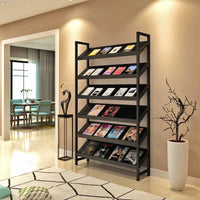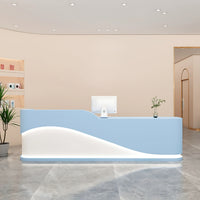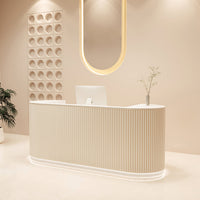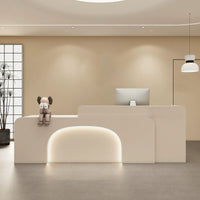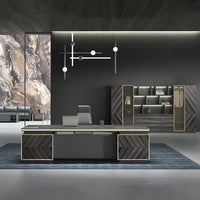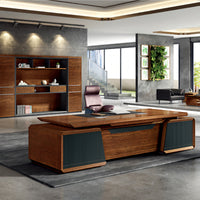How Many People Can Sit at a Conference Table?
kaguyasuContent Menu
● Understanding Conference Table Dimensions and Seating Capacity
>> Standard Conference Table Sizes
>> Seating Capacity per Table Length
>> Chair Size and Spacing
● Factors Influencing Seating Capacity
>> Purpose of the Meeting
>> Table Shape and Sightlines
>> Room Size and Layout
>> Additional Furniture and Equipment
● Calculating Seating Capacity: Step-by-Step Guide
>> Step 1: Measure the Table Perimeter
>> Step 2: Determine Space per Person
>> Step 3: Divide Total Perimeter by Space per Person
>> Step 4: Adjust for Comfort and Room Constraints
● Examples of Seating Capacities for Common Table Sizes
● Tips for Maximizing Seating Capacity
● Common Questions About Conference Table Seating
>> How many people can sit at a 10-foot conference table?
>> Can round tables seat more people than rectangular ones?
>> What is the ideal space per person at a conference table?
>> How does table shape affect meeting dynamics?
>> What room size is needed for a conference table seating 12 people?
>> Summary
>> Related Questions and Answers
When planning meetings, conferences, or collaborative sessions, one of the most critical considerations is the seating capacity of the conference table. The number of people who can sit comfortably at a conference table depends on several factors including the table's shape, size, and the type of chairs used. This article explores these factors in detail, providing guidance on how to determine the appropriate seating capacity for various conference table configurations.

Understanding Conference Table Dimensions and Seating Capacity
Standard Conference Table Sizes
Conference tables come in various shapes and sizes, each designed to accommodate different numbers of participants. The most common shapes include rectangular, oval, round, and boat-shaped tables.
- Rectangular tables are the most traditional and widely used. They typically range from 6 feet (about 183 cm) to 20 feet (about 610 cm) in length.
- Oval tables offer a softer aesthetic and usually provide similar seating capacity to rectangular tables of comparable length.
- Round tables are ideal for smaller groups and encourage more inclusive communication.
- Boat-shaped tables taper at the ends, providing a modern look and often better sightlines for participants.
Seating Capacity per Table Length
A general rule of thumb for rectangular and oval tables is that each person requires approximately 24 inches (61 cm) of table edge space to sit comfortably. This measurement allows enough room for chairs, elbow space, and personal items.
- For example, a 6-foot (72 inches) rectangular table can seat about 3 people on each side, totaling 6 people.
- A 12-foot (144 inches) table can seat about 6 people on each side, totaling 12 people.
- Adding seating at the ends can increase capacity by 1 or 2 more people.
Round tables are measured by diameter, and the seating capacity depends on the size:
- A 4-foot (48 inches) round table comfortably seats 4 people.
- A 6-foot (72 inches) round table can seat 6 to 8 people.
- Larger round tables of 8 feet (96 inches) or more can seat 10 or more people, but communication may become more difficult as the table grows.
Chair Size and Spacing
The size of chairs and the spacing between them also affect how many people can fit around a table. Standard office chairs typically require about 20 to 24 inches of width per person. If larger executive chairs or armchairs are used, more space per person is necessary.
Allowing at least 6 to 12 inches of space between chairs ensures comfort and ease of movement. Tight spacing can make meetings uncomfortable and reduce productivity.
Factors Influencing Seating Capacity
Purpose of the Meeting
The nature of the meeting influences how much space each participant needs. For example:
- Formal meetings with laptops, documents, or meals require more space per person.
- Casual discussions or brainstorming sessions may allow for closer seating arrangements.
Table Shape and Sightlines
The shape of the table affects how well participants can see and hear each other.
- Rectangular tables may create a hierarchy, with the head of the table seen as the leader.
- Round and oval tables promote equality and better eye contact.
- Boat-shaped tables help improve sightlines by tapering ends.
Room Size and Layout
The overall size of the conference room limits the maximum table size and seating capacity. There should be enough clearance around the table for people to move freely, typically at least 36 inches (91 cm) from the table edge to the walls or other furniture.
Additional Furniture and Equipment
Conference rooms often include presentation equipment, side tables, or storage cabinets. These items reduce available space and may affect seating arrangements.
Calculating Seating Capacity: Step-by-Step Guide
Step 1: Measure the Table Perimeter
Calculate the total length of the table edges where people will sit. For rectangular tables, this includes both long sides and possibly the short ends. For round tables, use the circumference formula $$ C = \pi \times d $$, where $$ d $$ is the diameter.
Step 2: Determine Space per Person
Decide on the amount of space each person needs. The standard recommendation is 24 inches (61 cm) per person, but this can be adjusted based on chair size and meeting type.
Step 3: Divide Total Perimeter by Space per Person
Divide the total seating perimeter by the space per person to get the maximum number of seats.
Step 4: Adjust for Comfort and Room Constraints
Consider adding extra space for comfort or reducing seats if the room size or furniture layout limits movement.
Examples of Seating Capacities for Common Table Sizes
| Table Shape | Dimensions (feet) | Approximate Seating Capacity |
|---|---|---|
| Rectangular | 6 x 3 | 6 |
| Rectangular | 12 x 4 | 12 |
| Oval | 10 x 4 | 10 |
| Round | 4 (diameter) | 4 |
| Round | 6 (diameter) | 6 to 8 |
| Boat-shaped | 10 x 4 | 8 to 10 |
Tips for Maximizing Seating Capacity
- Use slimmer chairs to fit more seats without sacrificing comfort.
- Consider modular tables that can be rearranged based on meeting size.
- Avoid clutter around the table to allow for easy movement.
- Use technology like wireless presentations to reduce the need for large table space.
Common Questions About Conference Table Seating
How many people can sit at a 10-foot conference table?
A 10-foot rectangular table typically seats 10 people comfortably—4 to 5 on each side and 1 at each end.
Can round tables seat more people than rectangular ones?
Round tables generally seat fewer people than rectangular tables of the same perimeter because they lack corners for additional seating.
What is the ideal space per person at a conference table?
The ideal space per person is about 24 inches (61 cm) for comfort, but this can vary depending on chair size and meeting type.
How does table shape affect meeting dynamics?
Round and oval tables promote equality and collaboration, while rectangular tables can create a hierarchical seating arrangement.
What room size is needed for a conference table seating 12 people?
A room should allow at least 36 inches (91 cm) clearance around the table, so for a 12-person table approximately 12 feet by 16 feet room is recommended.
---
Summary
Determining how many people can sit at a conference table depends on the table's shape, size, chair dimensions, and the meeting's purpose. Rectangular tables require about 24 inches per person along the edge, while round tables' seating depends on diameter. Comfort, sightlines, and room layout also influence seating capacity. By measuring the table perimeter and dividing by space per person, you can estimate seating capacity and adjust for comfort and room constraints. Proper planning ensures productive and comfortable meetings.
Related Questions and Answers
1. How many people can sit at a 6-foot conference table?
About 6 people can sit comfortably, 3 on each side.
2. What is the best table shape for collaborative meetings?
Round or oval tables are best as they promote equality and better communication.
3. How much clearance is needed around a conference table?
At least 36 inches (91 cm) clearance is recommended for movement.
4. Can conference tables be extended for more seating?
Yes, modular or extendable tables can increase seating capacity as needed.
5. What chair size is ideal for conference rooms?
Chairs about 20 to 24 inches wide are standard, balancing comfort and space efficiency.

Hot Tags: China, Global, OEM, private label, manufacturers, factory, suppliers, manufacturing company



